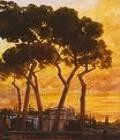
I-PINES OF THE VILLA BORGHESE, II-PINES NEAR A CATACOMB, III-PINES OF THE JANICULUM, IV-PINES OF THE APPIAN WAY. AN EPIC SONG FROM THE ROMAN TRILOGY OF SYMPHONIC POEMS BY OTTORINO RESPIGHI. PERFORMED DURING MY SENIOR YEAR IN THE TMEA ALL STATE BAND.
highschool bands
jazz bands
college bands
all region bands
community bands
concert bands
honor bands
interlochen arts academy
marching bands
national music camp
tmea all state bands
university bands
Story behind the song
This is performed by the TMEA All State Symphonic Band, conducted by the famed director, Frederick Fennell. This is from my final year, my senior year in the band.
Ottorino Respighi's symphonic poem The Pines of Rome was the second in a triptych of works paying tribute to The Eternal City. The piece's first movement shows children playing outside the Villa Borghese, the opulent home of one of Rome's most prominent 17th-century families. Pines Near a Catacomb depicts a solitary church in the middle of a Roman field dotted with pine trees, the section's ominous melody building to a sweeping climax. In the third movement, Respighi paints a musical portrait of the Pines of the Janiculuma at night. The Janiculum was one of Rome's seven hills, so named because it was the site of temple of Janus, the Roman god of portals and the new year. In this section, Respighi specified the use of a gramophone recording of birdsong to capture the atmosphere perfectly. The work closes with a portrait of the pine tree-lined Appian Way, the military road of the Roman Republic. The Roman legions emerge from the mists, and the orchestra mirrors their approach, growing louder as the soldiers get closer to the Capitoline Hill. As the movement closes, the victorious warriors, led by the Republican Consul, arrive at the Capitol with the rising sun behind them, their glory reflected in the work's jubilant closing pages. The Pines of Rome was, and continues to be, a great success and popular favorite, so much so that Respighi used the money he made from it to buy a villa, which he appropriately named The Pines.
Respighi was, after opera master Giacomo Puccini, Italy's most famous composer of the 20th century. He used the modern orchestra to evoke the world around him with cinematic sweep and Technicolor vividness. His triptych of symphonic works inspired by Rome (The Fountains of Rome, The Pines of Rome, and Roman Festivals) brought him international renown and financial success (he named his estate "The Pines" in honor of the music that allowed him to buy it).